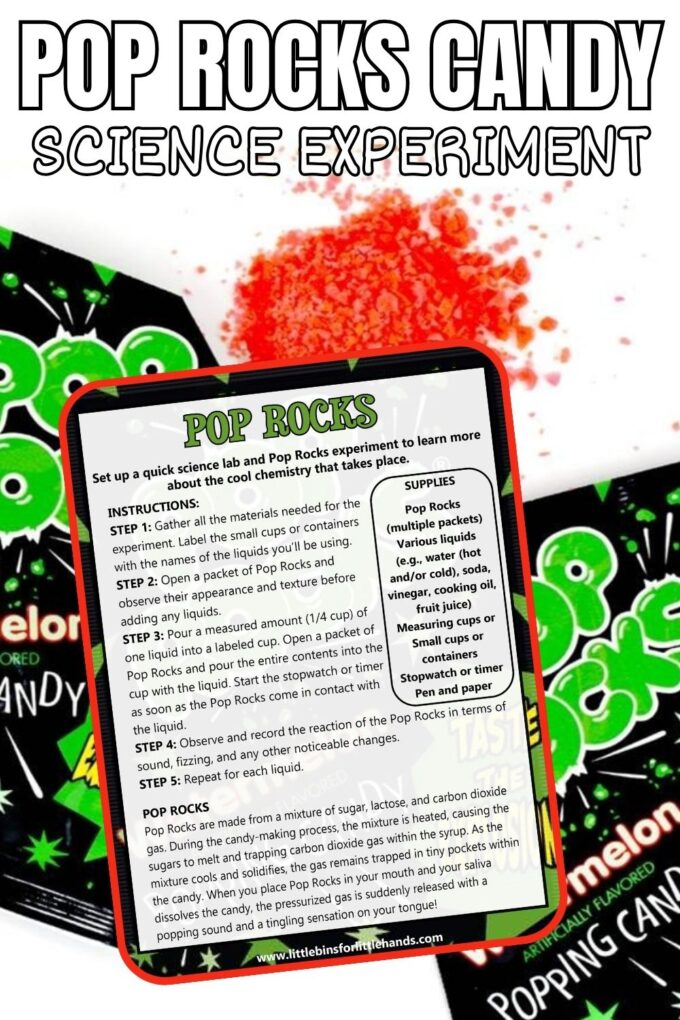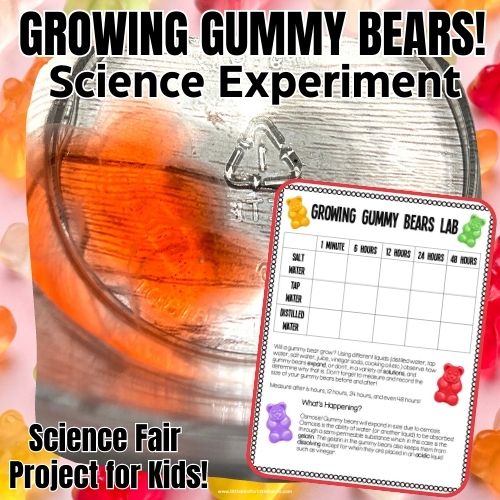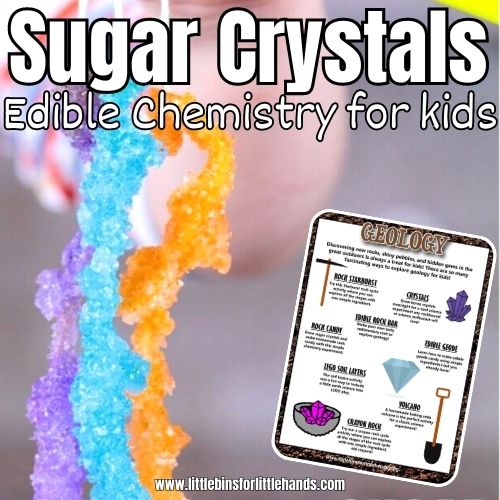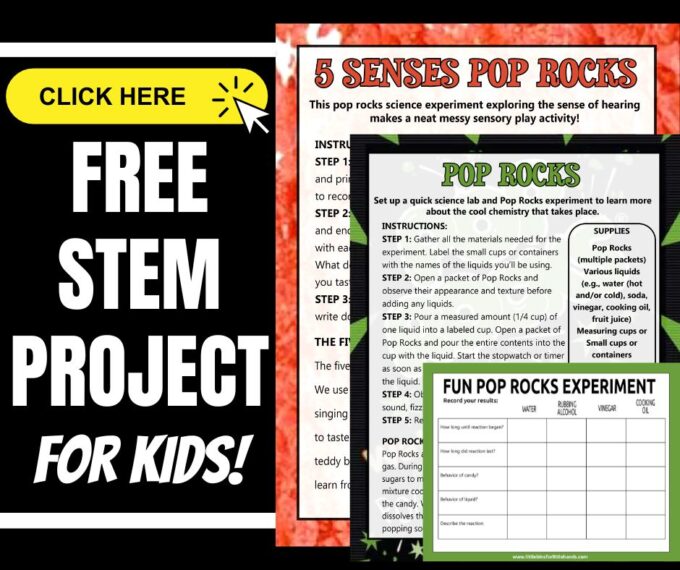Pop Rocks are a super fun candy filled with science! What can you learn from adding pop rocks to a classic science experiment? SO much! What are Pop Rocks and how do Pop Rocks work? Plus, you can set up a quick science lab and Pop Rocks experiment to learn more about the cool chemistry that takes place.

What are Pop Rocks?
Pop Rocks are a type of candy known for producing a fizzy and crackling sensation in the mouth when consumed. This unique sensation is created by releasing carbon dioxide gas, which is responsible for the popping and crackling sounds.
You Might Also Enjoy: Pop Rocks and the 5 Senses
How Do Pop Rocks Work?
The candy’s unique texture and sensation are a result of both the trapped gas and the hard candy matrix breaking down as it dissolves in your mouth. This combination of factors leads to the distinctive popping experience that people associate with Pop Rocks.
Here’s how Pop Rocks works:
Carbon Dioxide Gas: Pop Rocks are made by trapping carbon dioxide gas within the candy. Carbon dioxide is the same gas that gives carbonated beverages their bubbles and fizziness.
Sugar Matrix: The candy is made from a mixture of sugar, corn syrup, and flavoring. The sugar mixture is heated until it melts, and then it is pressurized with carbon dioxide gas. The pressurized carbon dioxide becomes dissolved within the molten sugar mixture.
Rapid Cooling and Hardening: The pressurized sugar mixture is then rapidly cooled and solidified. This traps the carbon dioxide gas bubbles within the candy matrix.
Crystalline Structure: As the candy solidifies, it forms a hard and brittle structure. The trapped carbon dioxide gas is dispersed as tiny bubbles throughout the candy.
Release of Gas: When you place Pop Rocks in your mouth and your saliva starts to dissolve the candy, the pressure within the bubbles changes. This sudden change in pressure causes the carbon dioxide gas to rapidly escape from the bubbles, creating the characteristic popping and crackling sensation.
Easy Pop Rocks Science Experiment
Doing a science experiment with Pop Rocks can be both fun and educational. Kids love experimenting with candy. Alternatively, you can check out our Pop Rocks and Soda Experiment
Title: Investigating the Effects of Liquids on Pop Rocks
Objective: To observe and compare the reaction of Pop Rocks when placed in different liquids.
Free Printable Pop Rocks Experiment
Supplies:
- Pop Rocks (multiple packets)
- Various liquids (e.g., water (hot and/or cold), soda, vinegar, cooking oil, fruit juice)
- Measuring cups or graduated cylinders
- Small cups or containers
- Stopwatch or timer
- Pen and paper for recording observations
Instructions:
STEP 1: Gather all the materials needed for the experiment. Label the small cups or containers with the names of the liquids you’ll be using.
STEP 2: Open a packet of Pop Rocks and observe their appearance and texture before adding any liquids.
STEP 3: Pour a 1/4 cup of one liquid into a labeled cup. Open a packet of Pop Rocks and pour the entire contents into the cup with the liquid.
Start the stopwatch or timer as soon as the Pop Rocks come in contact with the liquid.
Observe and record the reaction of the Pop Rocks in terms of sound, fizzing, and any other noticeable changes. e. Note the time it takes for the reaction to slow down and stop. Repeat steps for each type of liquid you want to test.
STEP 4: Record your observations for each liquid tested, including the time the reaction occurred and any differences you noticed between the liquids.
Analyze your observations. Which liquids caused the most vigorous reaction? Were there any differences in how long the reactions lasted?
STEP 5: Compare your results and discuss why different liquids might have caused varying reactions with the Pop Rocks. Consider the factors that might influence the reactions. Summarize your findings and draw conclusions about the effects of different liquids on the Pop Rocks.
Remember, the key to a successful science experiment is careful observation and recording of results. This experiment can be a great way to introduce concepts like chemical reactions to young learners while having a blast with Pop Rocks’s popping and fizzing effects!
Turn It Into A Science Project
Science projects are an excellent tool for older kiddos to show what they know about science! Plus, they can be used in all sorts of environments, including classrooms, homeschools, and groups.
Kids can take everything they have learned about using the scientific method, stating a hypothesis, choosing variables, making observations, and analyzing and presenting data.
Want to turn one of these experiments into an awesome science fair project? Check out these helpful resources.
More Candy Science Experiments
Candy is a super fun material that can be added to a variety of science demonstrations to illustrate different concepts. Plus, it keeps the kids engaged. You can find even more candy science ideas here. Great for leftover Halloween candy!



Helpful Science Resources
Here are a few resources that will help you introduce science more effectively to your kiddos or students and feel confident when presenting materials. You’ll find helpful free printables throughout.
- Best Science Practices (as it relates to the scientific method)
- Science Vocabulary
- 8 Science Books for Kids
- All About Scientists
- Science Supplies List
- Science Tools for Kids
Printable Science Projects For Kids
If you’re looking to grab all of our printable science projects in one convenient place plus exclusive worksheets and bonuses like a STEAM Project pack, our Science Project Pack is what you need! Over 300+ Pages!
- 90+ classic science activities with journal pages, supply lists, set up and process, and science information. NEW! Activity-specific observation pages!
- Best science practices posters and our original science method process folders for extra alternatives!
- Be a Collector activities pack introduces kids to the world of making collections through the eyes of a scientist. What will they collect first?
- Know the Words Science vocabulary pack includes flashcards, crosswords, and word searches that illuminate keywords in the experiments!
- My science journal writing prompts explore what it means to be a scientist!!
- Bonus STEAM Project Pack: Art meets science with doable projects!
- Bonus Quick Grab Packs for Biology, Earth Science, Chemistry, and Physics.










What a fun idea!
Looks like you guys had fun with this! Great science learning as well!
What a fun and creative experiment!
My kids have just recently discovered Pop Rocks. I never thought of how we could use them for science. Now I’m going to get those wheels turning to think of some new ideas.
So fun!